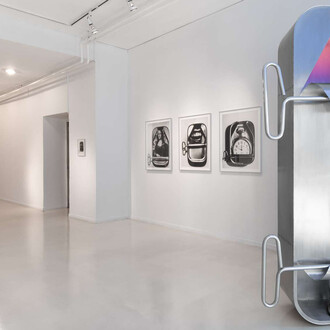In 2007, three Slovenian artists joined the conservative Slovenian Democratic Party (SDS) and officially changed their names to that of the leader of the party, the Prime Minister of Slovenia at the time, Janez Janša. While they renamed themselves for personal reasons, the boundaries between their lives and their art began to blur in numerous and unforeseen ways.
Since then, they have been living their private and public lives, working individually and collectively under the same name, and exploring the philosophical, psychological, political, biopolitical, historical, legal, economic, linguistic, and social implications of the name change; turning their lives into an ongoing performance and their art into a powerful means to question rituals and conventions, and to discuss the status and function of identity-related objects such as signatures, passports, ID cards, credit and debit cards.
Ten years later, this anthological exhibition offers an overview of this story which, although strongly rooted in Slovenia and its recent history, raises some universal questions about identity in the age of biopolitics and about art in the age of information; and casts it into the future, by announcing the registration of the Janez Janša name as a trademark for the next ten years. What’s in a name? How does it relate to ownership, legal status, self-perception and self-representation, profiling, surveillance, copyright and commodification of language, and related topics that define the contemporary condition? What’s an artwork and what are the boundaries that define it in relation to life, institutions and companies?
Co-produced by Moderna galerija (MG+MSUM) and Aksioma – Institute for Contemporary Art, Ljubljana, and curated by independent curator Domenico Quaranta, Janez Janša® presents a comprehensive selection of works and projects produced by Janez Janša, Janez Janša and Janez Janša over the last ten years – most of them arising as collateral effects of the name change or other life events related to it. As an action pursued with no explicit artistic or political agenda, the name change sparked a series of consequences, reactions and interpretations that were either political or artistic. From an artistic perspective, the name change was perceived as either a performance or provocation. From a political perspective, it was perceived as either an act of political affiliation or resistance. These interpretations were often reflected in public statements and media stories. From a plain administrative perspective, the name change was seen as a regular procedure that – automatically or upon request – produced the related documents, such as ID cards and passports, birth and marriage certificates, and so on.
The exhibition is part of State Machines - Art, Work, and Identity in an Age of Planetary-Scale Computation, a project that investigates the new relationships between states, citizens and the stateless made possible by emerging technologies, focussing on how such technologies impact identity and citizenship, digital labour and finance.
















